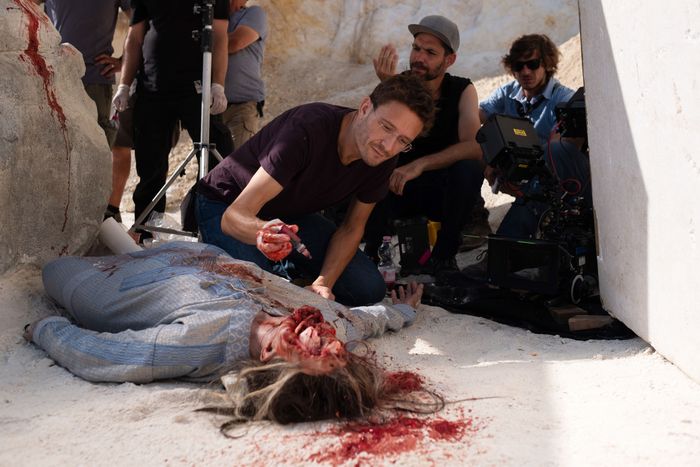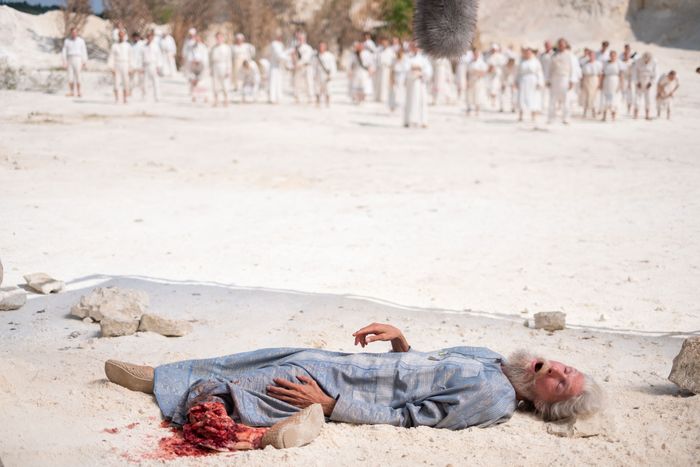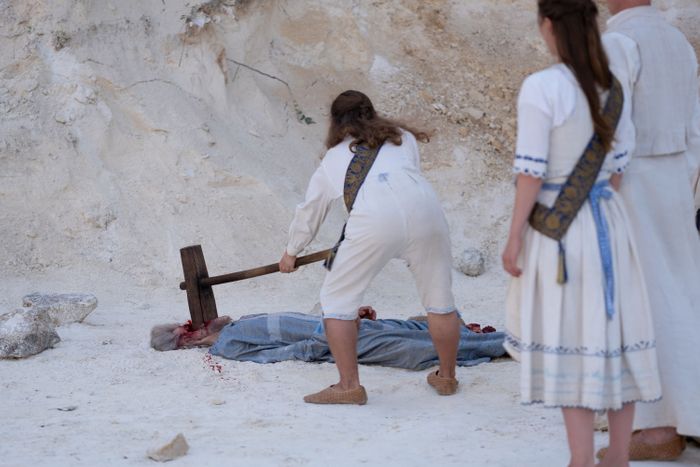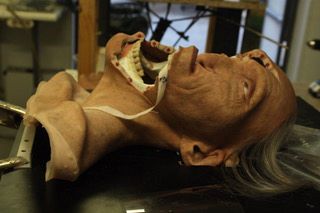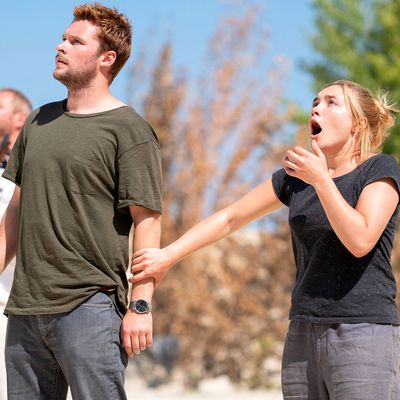
This post contains spoilers for Midsommar.
My experience of watching Midsommar was one of constant questioning. How freaky would it be to be tripping in a land of constant sunshine? What would actual Swedish people think of the implication that beneath their friendly smiles and rigid adherence to traffic laws, they’re all secretly members of pagan death cults? And in the moments after two 72-year-olds threw themselves off a cliff in a re-creation of the possibly apocryphal Scandinavian ritual of Ättestupa, a scene that ended with one of them getting his brains bashed in with a gigantic wooden mallet, two thoughts occupied my mind: (1) If I was Dani, this is about when I would try to leave, and (2) how did they do that?
The film subsequently disabused me of the wisdom of the former, but to get an answer for the latter, I called up the film’s prosthetic makeup designer, Iván Pohárnok. A protégé of legendary makeup artist Dick Smith (The Exorcist), Pohárnok began working in Hollywood as a young man before moving back to his native Hungary to start his own company, Filmefex, in 1996. Years later, the studio’s work on the 2014 Swedish short, A Living Soul, not only gave Pohárnok the opportunity to create a sentient brain that lived in a fish tank, it also introduced him to producer Patrik Andersson. The two would reunite when it became clear that Andersson’s new project Midsommar would be shooting in Hungary. Pohárnok’s effects company seemed the perfect choice to bring the nastiest bits of Ari Aster’s script to life — er, death.
Filmefex is something of a specialist in human remains, having provided realistic corpses for The Terror, The Alienist, and Blade Runner 2049. (Though technically in the latter they were Replicants.) Most notably for certain cinephiles, Pohárnok’s company also did the effects for the 2006 Hungarian film Taxidermia, a carnival of grotesqueries that climaxes with the titular taxidermist turning his own cadaver into a work of art. That movie gained a small cult following in the States, and as luck would have it, Aster was among them. Pohárnok returned the compliment. “If I was to work on a horror movie, this was to be the one,” he says of Midsommar. “It has such a twisted, weird idea. I fell in love with it instantly.”
Over the course of Midsommar, 12 people die through methods as various as asphyxiation, blunt trauma, and being burned alive. It was Pohárnok’s job to make each look as horrific as possible. The basic method for creating a fake corpse onscreen has not changed much over the years. Effects artists take a cast of an actor’s body, then use that mold to create a realistic silicone rubber dummy. (Luckily for actors, they don’t have to submit to this process every time they appear in a new film. As Will Poulter told Vulture, his character’s corpse in Midsommar was created partially from the cast he’d done for The Little Stranger.) The advent of 3-D printing has been transformative, though. Now effects artists have the option of digitally scanning someone and then tinkering with their dummy designs on a computer, which helps save time.
That sort of time-saving was necessary on Midsommar. Due to Aster also having to finish Hereditary, preproduction on the film was somewhat rushed. Casting took place later in the process than usual, so the other kind of casting had to wait, as well. “The time we got for making each individual body was kind of short,” Pohárnok says. And since the corpses would often be seen in states of undress, each hair on the dummies had to be painstakingly added by hand. “Several people were working for weeks to put in all that hair — eyebrows, eyelashes, hair, chest hair, arms, legs,” Pohárnok says. “There’s no quick way to do that.”
Many of the bodies in Midsommar are defiled or distorted. The Swedish commune’s British visitors are so freaked out by the Ättestupa ritual that they attempt to leave early, and get murdered for their trouble. In a turn worthy of Taxidermia, the male half of the couple, Simon, gets turned into human origami, his organs exposed and folded into unconventional shapes, while the woman, Connie, is briefly glimpsed as a drowned body, bloated and waterlogged nearly beyond recognition. On both, achieving Aster’s vision required plenty of creativity and digital experimentation, but the bodies that would be smashed in the Ättestupa scene entailed a different kind of blunt ingenuity. The script called for one of the jumpers to survive the fall, which meant combining a living actor with prosthetics of bloody, broken limbs. The solution came from old-school movie magic — they dug a big hole for actor Björn Andrésen, put him in it with only his head sticking out, then placed a dummy body on top. Presto, a writhing, mangled mess!
A short while later, Andrésen’s head is smashed to a pulp. Doing it for real was probably against SAG regulations, but doing it with special effects came with its own complications. It would have been easy to just make a fake head, fill it with fake blood, and go to town — as long as Aster only needed to shoot one take. That was unlikely, and considering such a head takes around six weeks to build, making enough copies for every conceivable reset was unworkable. Pohárnok eventually had a Eureka moment: What if they built a skull that could smash itself, and then, later, un-smash itself? The Filmefex team created a head that would collapse in on itself with the push of a button, no mallet required: Pneumatic cylinders located in the fake head drove apart each section of the “skull,” imploding it from the inside. (As with Andrésen’s real body, most of the mechanics were hidden in a hole.) The head even squirted fake blood! Then with the push of another button, the whole thing would reset. “It worked beautifully,” Pohárnok says. “We just pressed the button and everything popped back into the original, pristine face.” All they had to do between takes was wash off the blood and the head was good to go, as many times as Aster needed.
But according to Pohárnok, his greatest challenge was not the smashed bodies in the Ättestupa scene, nor the artfully disassembled Simon. It was the bear. The beast, which A24 is definitely trying to make a thing, pops up on the margins of the Hårga’s commune before playing a major role in Midsommar’s show-stopping ending. First it’s alive, in a cage; then it’s dead, getting its intestines ripped out; then finally it’s a costume that Dani’s drugged-up boyfriend, Christian, is stuffed into before he’s burned to death in a ritual sacrifice. “We had to build a bear from scratch,” Pohárnok recalls, which is not as easy as certain workshops would have you believe. For one thing, the same bear had to be used in both the autopsy and the burning scenes. Complicating the latter even further, they didn’t yet have a Christian (Jack Reynor would eventually get the role and take part in his own live casting) when they had to start making the bear. “It had to function both ways,” Pohárnok says. “We had to create the bear to be partially a costume, and partially a dummy bear with loads of fake guts they could play with.”
The grossest element of the scene, though, was left on the cutting-room floor. As Reynor told Vulture, the original version of the bear-burning scene included a practical effect that went even further than what we saw onscreen: “My eyeball has exploded and my face is just melting.” Restraint is not a word that comes to mind when you think of Midsommar, but you can take solace in the fact that there was at least a little bit in the editing room, otherwise the scene might have really been unbearable.



